The Phrygian dominant scale is one of the most captivating and exotic musical scales you can incorporate into your music production.
It features a unique sequence of intervals and is made up of a root, half-step, augmented second, whole step, half-step, whole step, half-step, and whole step.
As a music producer, incorporating this unique scale can add a super intriguing vibe to your tracks, helping them stand out.
Plus, it can enhance your melodies and chords 一 giving your music an edge that captures listeners’ attention.
That’s why we’re breaking down everything you need to know, like:
- What is the Phrygian dominant scale?
- Phrygian dominant scale structure
- How to construct the Phrygian dominant scale
- Fingering chart for keyboard and guitar
- Phrygian dominant vs. Phrygian mode
- Modes related to the Phrygian dominant scale
- Chord progressions and harmonization (with examples)
- Creating melodies with the Phrygian dominant scale
- Phrygian dominant scale in music production
- Piano/guitar tips and tricks
- Much more
After reading this article, you’ll know everything about the Phrygian dominant scale and its various uses.
This way, you’ll be able to incorporate it in your own music, create epic compositions, and elevate your music production skills to new heights.
So, let’s dive in…
Table of Contents
- What is the Phrygian Dominant Scale?
- Phrygian Dominant Scale Structure: Breaking it Down
- Phrygian Dominant vs. Phrygian Mode: What’s The Difference?
- Modes Related to the Phrygian Dominant Scale
- Chord Progressions and Harmonization
- Creating Melodies with the Phrygian Dominant Scale
- Phrygian Dominant in Music Production (Expert Tips & Tricks)
- Phrygian Dominant Scale: Final Thoughts
What is the Phrygian Dominant Scale?
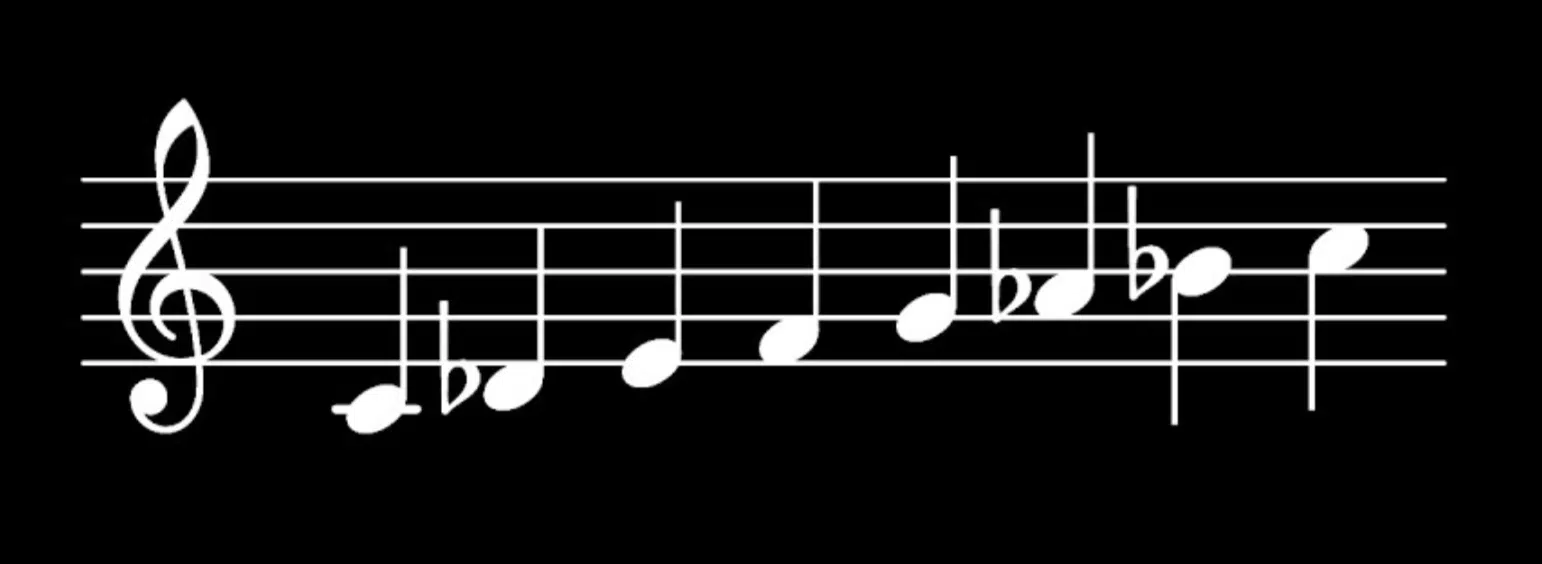
The Phrygian dominant scale is a captivating musical scale that brings an exotic and dramatic flavor to any track.
It’s derived from the fifth mode of the harmonic minor scale, and it’s known for its characteristic raised third note.
This gives it a distinct sound compared to the traditional Phrygian scale.
This scale is prevalent in flamenco, jazz, and Middle Eastern music 一 offering a rich, cultural sound variety from around the world.
For example, the Spanish Gypsy Scale is essentially the Phrygian dominant scale and is often used in Spanish and flamenco music for some added edge.
The unique sound of this scale comes from its specific sequence of intervals, creating a blend of tension and resolution.
It’s perfect for adding mystery and depth to your music.
NOTE: You might hear the Phrygian dominant scale also being called the Jewish scale, the Spanish Phrygian scale, or the Freygish scale, reflecting its use in Jewish, Spanish, and Middle Eastern musical traditions. They’re common names for this versatile scale.
Phrygian Dominant Scale Structure: Breaking it Down
The structure of the Phrygian dominant scale can be broken down into several key elements, so let’s break it down (no pun intended).
-
Scale Notes/Scale Formula and Intervals

The Phrygian dominant scale follows a specific sequence of scale notes and intervals, making it different from other musical scales.
The scale notes for the C Phrygian dominant scale are C, Db, E, F, G, Ab, and Bb.
This scale formula includes a:
- Half-step (semitone)
- Augmented second
- Whole step (whole tone)
- Half-step
- Whole step
- Half-step
- Whole step
The augmented second between the second and third scale notes is a defining feature 一 giving it that exotic feel people really react to.
Compared to the C major scale, where the sequence of intervals is more balanced, the Phrygian dominant scale’s intervals create a more dramatic sound.
These scale notes provide a unique tension and resolution that can be very effective in certain musical projects (it just depends on the vibe you’re going for).
For example, when played on the guitar, these notes create a distinct and captivating sound, often used in Middle Eastern music and flamenco styles.
-
Comparing Phrygian Dominant to Other Scales

When comparing the Phrygian dominant scale to other scales, its unique structure becomes super obvious.
Unlike the major scale, the Phrygian dominant scale features an augmented second interval between the second and third notes.
This difference in intervals gives it a more exotic and tense sound.
The harmonic minor scale shares some similarities (as we’ll break down a little later) but also has different intervallic relationships.
For instance, in the C harmonic minor scale, the raised seventh note creates a different tension compared to the Phrygian dominant scale.
Another example is the Mixolydian scale, which has a different set of intervals 一 resulting in a more bluesy and less dramatic sound.
These comparisons highlight how the Phrygian dominant scale stands out with its unique intervals and emotional impact.
-
Pro Tip: Fingering Chart for Keyboard and Guitar

To play the Phrygian dominant scale on the piano keyboard, use the following fingering:
- Start with your thumb on the root note
- Use your index finger for the half-step
- Your middle finger for the augmented second
- Continue this pattern up the scale
On the guitar, you can use a specific fretboard pattern to play the scale.
Start on the root note and follow the interval pattern 一 making sure to use proper finger positioning for smooth transitions.
Practicing these fingering charts will help you become comfortable with the scale across different instruments.
This versatility allows you to apply the Phrygian dominant scale to your compositions and improvisations.
Phrygian Dominant vs. Phrygian Mode: What’s The Difference?

The Phrygian dominant scale and the Phrygian mode share similarities but have key differences.
The Phrygian mode is derived from the major scale and has the following intervals: half-step, whole step, whole step, whole step, half-step, whole step, whole step.
The Phrygian dominant scale, on the other hand, has a raised third 一 creating an augmented second interval between the second and third notes.
This difference gives the Phrygian dominant scale degrees its unique, exotic sound compared to the darker, more somber Phrygian mode.
Understanding these differences helps in choosing the right scale for the desired musical effect (which makes a world of difference).
Modes Related to the Phrygian Dominant Scale
Understanding the relationship between the Phrygian dominant scale and other modes can deepen your musical knowledge and enhance your chords/melodies/harmonies.
-
Relationship With Other Musical Modes (e.g., Dorian, Lydian, Mixolydian Mode)
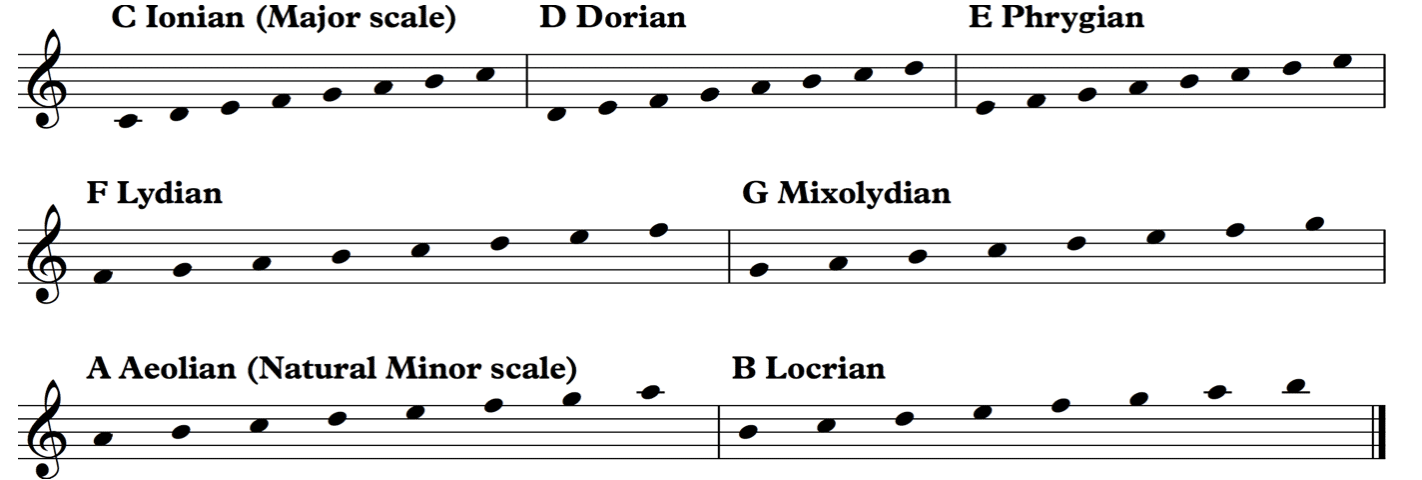
The Phrygian dominant scale has intriguing relationships with other musical modes, such as Dorian, Lydian, and Mixolydian, so let’s break it down.
The Dorian mode, often used in jazz and rock, has a natural sixth that gives it a bright, almost major-like quality.
It contrasts with the exotic tension of the Phrygian dominant scale.
For instance, while the Dorian scale can sound uplifting and smooth, the Phrygian dominant scale offers a dramatic and tension-filled feel.
The Lydian mode, characterized by its raised fourth, provides a different kind of brightness and dissonance compared to the dark and mystifying sound of the Phrygian dominant scale.
The Mixolydian scale, with its flattened seventh, delivers a bluesy and less dramatic sound, yet it shares the same major third with the Phrygian dominant scale.
These musical modes have distinct characteristics but can be swapped out creatively to evoke specific emotions and atmospheres in your music.
By playing around with these modes, you can create dynamic shifts and keep your compositions engaging 一 highlighting the unique intervals and qualities of each scale.
-
How it Fits Within the Harmonic Minor Scale

The Phrygian dominant scale is, of course, linked to the harmonic minor scale, as it is derived from its fifth mode.
Let’s take the C harmonic minor scale for example (C, D, Eb, F, G, Ab, B) 一 starting on the fifth degree, G, gives you the G Phrygian dominant scale (G, Ab, B, C, D, Eb, F).
This scale shares many of the same notes and intervals as the harmonic minor scale but emphasizes different root notes and intervals, giving it a signature sound.
The Phrygian dominant scale’s augmented second interval between the second and third notes (e.g., Ab to B in G Phrygian dominant) creates a unique tension that isn’t heard in the harmonic minor’s straightforward progression.
This relationship means you can easily transition between these scales to add variety and depth to your music as a producer.
For instance, a melody in the C harmonic minor scale can smoothly shift into the G Phrygian dominant scale to add an unexpected (yet harmonious) twist.
Understanding this fit allows for creative scale blending when you’re laying down a track or trying to break out of beat-block.
Chord Progressions and Harmonization

Chord progressions within the Phrygian dominant scale can give you endless possibilities when it comes to harmony.
A common progression in this scale involves using:
- A minor chord on the root/tonic note
- A major chord on the third degree
- Another major chord on the fifth degree
For example, in the C Phrygian dominant scale, you can use the chords Cm (C minor), E (E major), and G (G major).
This combination creates a powerful blend of tension and resolution, characteristic of the Phrygian dominant sound.
You can also incorporate other chords like the diminished chord on the second degree or the augmented chord on the seventh degree to add more complexity.
Pro Tip
Harmonizing melodies using these chords can evoke strong emotions and give your music a unique edge. It’s perfect for genres that thrive on dramatic and exotic sounds, such as flamenco and jazz.
Creating Melodies with the Phrygian Dominant Scale

Creating melodies with the Phrygian dominant scale involves taking advantage of its unique intervals and more dramatic effect.
Start by exploring the scale notes and experimenting with different sequences to find patterns that resonate with you.
For example, using the augmented second interval can add an exotic feel to your melodies 一 incorporating the scale’s overload of tension and release.
It will enhance the emotional impact of your music and make people really stop and listen (which is really the whole point, if you will).
Try improvising melodies over backing tracks to get a feel for how the scale interacts with different chords.
By practicing regularly, you’ll develop a strong sense of how to use the Phrygian dominant scale like a boss in your tracks.
Phrygian Dominant in Music Production (Expert Tips & Tricks)
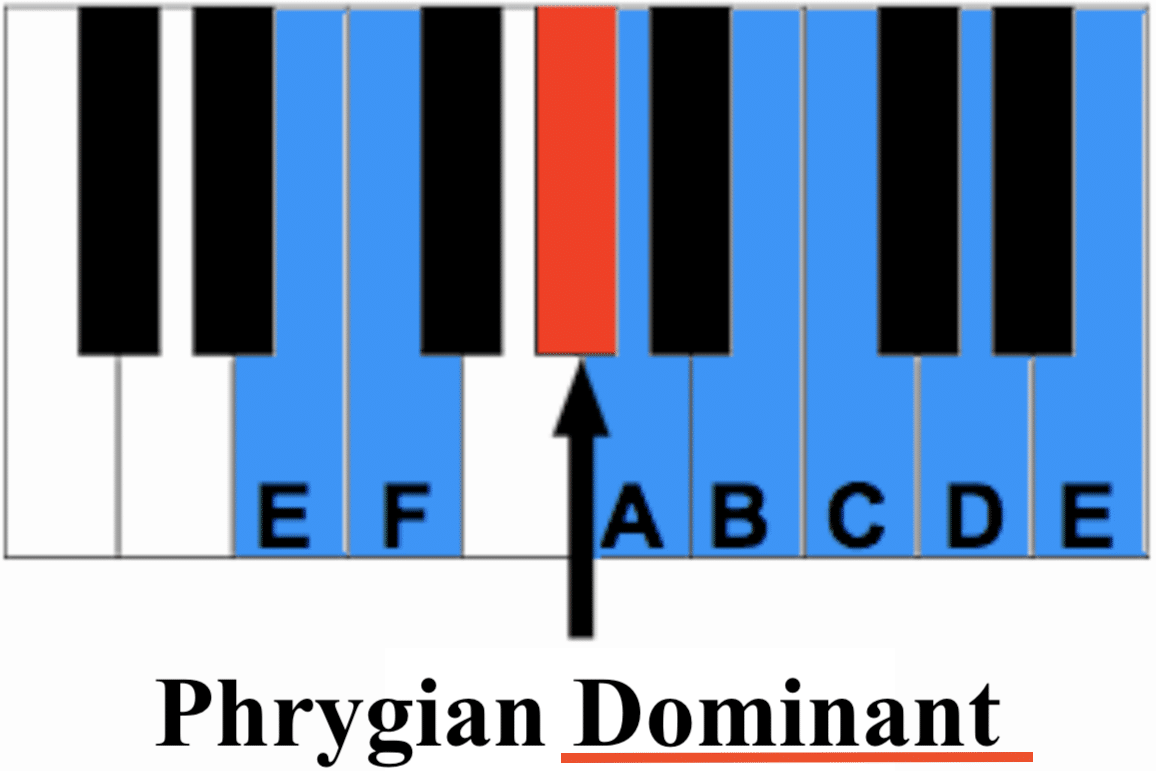
When it comes to music production, incorporating the Phrygian dominant scale can add an exotic and captivating dimension to your tracks.
It’s one of the lesser-used scales, so your track certainly won’t be basic or boring.
One tip is to layer instruments that accentuate the scale’s unique sound, such as:
- The Spanish guitar
- Oud
- Traditional Middle Eastern instruments
For electronic music producers, using synth patches that mimic these timbres can create a similar effect.
Playing around with different chord progressions and melodies within the Phrygian dominant scale can help you develop a killer atmosphere.
Pro Tip
You can start with a simple progression like Cm – E – G and build complex, evolving melodies over it.
Utilizing the Phrygian dominant scale in your tracks can make your tracks stand out and resonate with listeners looking for something more unique and emotionally engaging (which is, spoiler alert, most people).
-
Combining Phrygian Dominant with Other Scales
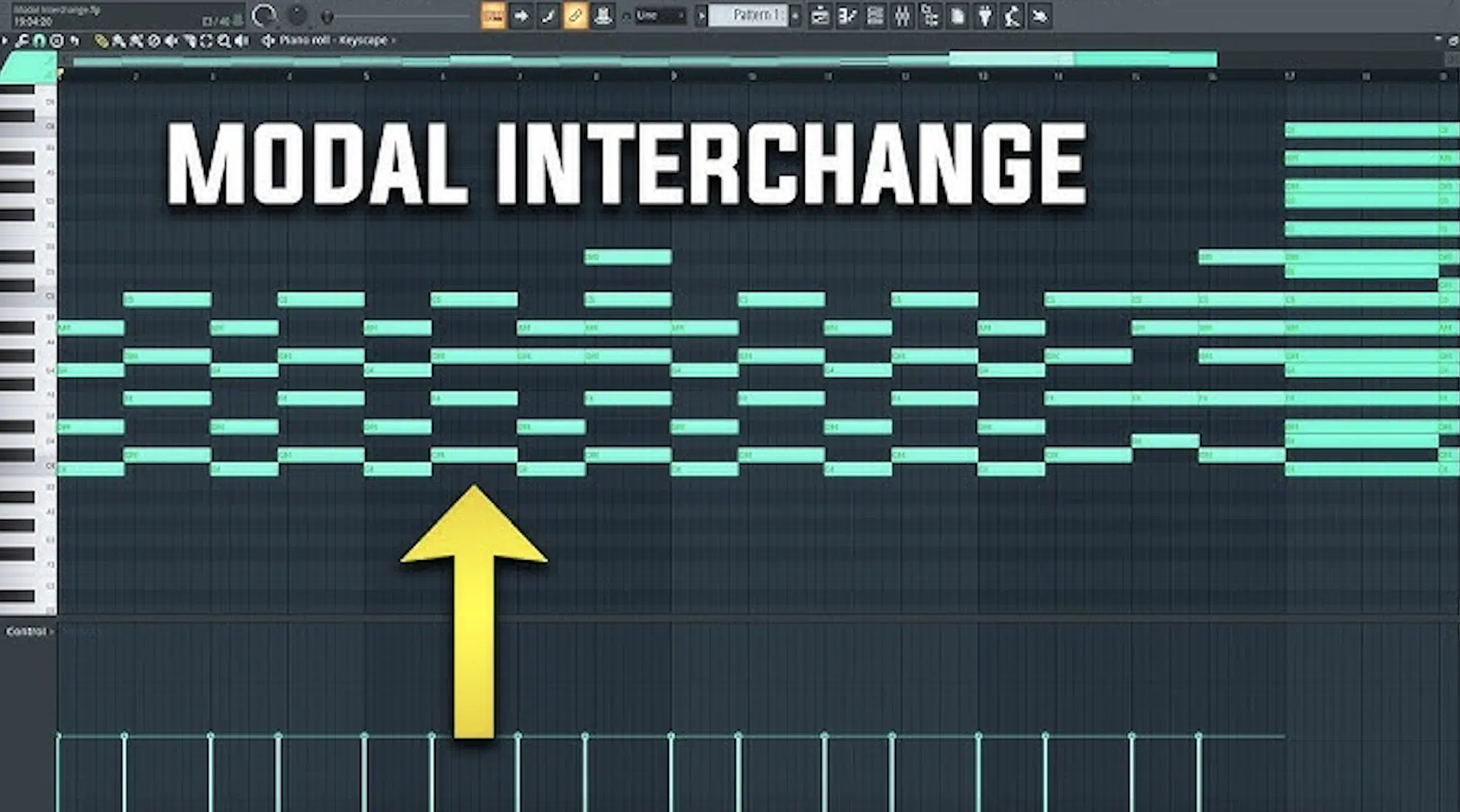
Combining the Phrygian dominant scale with other scales can create interesting textures.
For example, you can blend it with the major scale to add brightness and contrast to your compositions.
Also, try messing around with modal interchange 一 switching between the Phrygian dominant scale and other modes like Dorian or Lydian.
This can successfully create dynamic shifts and keep your music engaging.
By understanding the relationship between different scales, you can create unique and compelling musical pieces and break music theory rules effectively.
Pro Tip: Enhancing Your Compositions with the Phrygian Dominant Scale
When incorporating the Phrygian dominant scale into your tracks, try transitioning between a minor key and a major key to create dynamic contrast. For instance, you can start a section in a minor key, such as A minor, and then shift to the Phrygian dominant scale of the same root to add an exotic twist.
-
Software and Tools for Practicing Different Scales
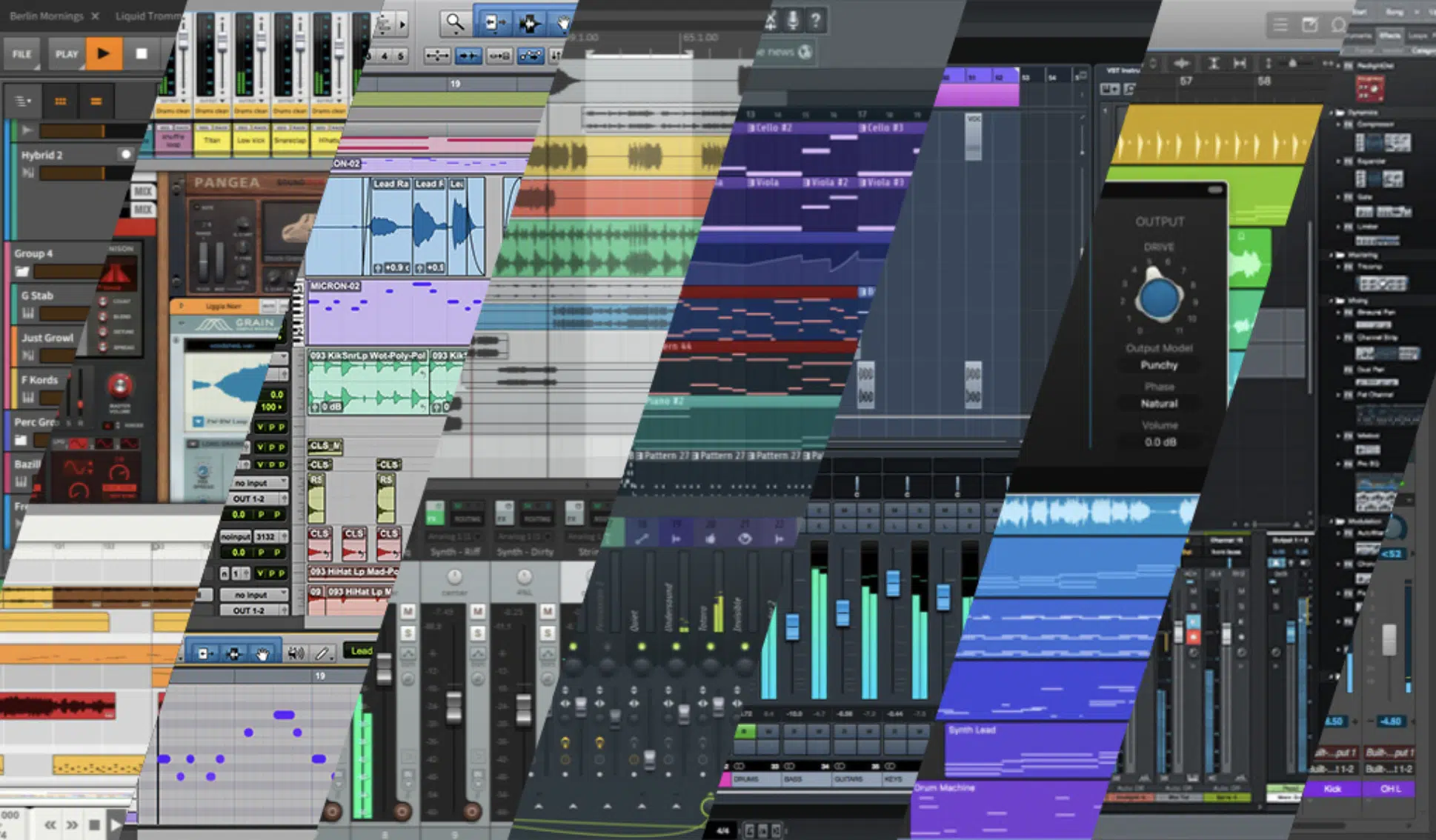
Practicing the Phrygian dominant scale can be a lot easier with the right software and tools at your disposal.
Even your Digital Audio Workstation (DAW), whether it’s Ableton Live or FL Studio, have built-in tools for practicing scales and creating backing tracks.
There are also an abundance of plugins that simulate traditional instruments, like the flamenco guitar or Middle Eastern oud.
It can help you hear the unique sound of the Phrygian dominant scale and create common chords.
Online resources like music theory websites and YouTube tutorials also offer lessons and exercises tweaked to this unique scale.
Bottom line, various tools and courses can help you practice and master the Phrygian dominant scale like a true professional.
-
Bonus: Advanced Techniques When Using the Phrygian Scale

To take your use of the Phrygian scale to the next level, explore advanced techniques like modal interchange and chord substitutions.
For example, try substituting chords from the altered Phrygian scale to add tension and complexity to your progressions.
Another advanced technique is to use the scale in different positions on the guitar fretboard 一 exploring its unique sound in various octaves.
You can also experiment with different rhythms and phrasings, such as using syncopation or polyrhythms to create a more dynamic sound.
Also, using the Phrygian dominant scale in jazz improvisation can add a unique flavor to your solos (super beneficial).
By incorporating these advanced techniques, you can expand your musical vocabulary and create more interesting compositions every single time.
Phrygian Dominant Scale: Final Thoughts
The Phrygian dominant scale, as you now know, is a powerful and exotic scale that can add a unique and dramatic edge to your tracks.
It can help you add some extra mystery and depth to your music.
Plus, if you’re able to master its use, you can create amazing, captivating music like a true professional.
But don’t worry, using the tips and tricks from this article, you’ll be able to incorporate the Phrygian dominant scale into your music in no time.
For the absolute best way to learn about this intriguing scale, you’ve got to check out the Unison Harmonic Dominant (Flamenco) Advanced Scales MIDI Collection.
It’s the easiest and most effective way for you to create high-quality Phrygian dominant scales, chords, progressions, and melodies that will make your music stand out.
You’ll instantly be able to create 1,100+ musical elements, to be exact.
This collection will help you create a unique energy that makes people want to move, dance, and gives them a feeling of freedom and ease.
Plus, it eliminates the need to spend years learning music theory by providing all the melodic elements you need.
And make your tracks sound much more advanced, professional, and show-stopping.
Remember, never stop learning, growing, and evolving as a music producer.
The more you explore different scales and musical concepts, the more efficiently you’ll be able to break the rules and enhance your creativity.
Until next time…







Leave a Reply
You must belogged in to post a comment.